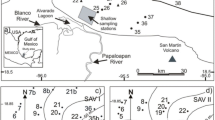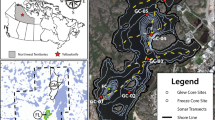Abstract
Acoustic remote sensing is a highly effective tool for exploring the seafloor of both deep and shallow marine settings. Indeed, the acoustic response depends on several physicochemical factors such as sediment grain size, bulk density, water content, and mineralogy. The objective of the present study is to assess the suitability of seismic peak amplitude as a predictor of total organic carbon (TOC) content in shallow marine sediments, based on data collected in the Cabo Frio mud belt in an upwelling zone off southeastern Brazil. These comprise records of P-wave velocity (V P) along 680 km of high-resolution single-channel seismic surveys, combined with analyses of grain size, wet bulk density, absolute water content and TOC content for four piston-cores. TOC contents of sediments from 13 box-cores served to validate the methodology. The results show well-defined positive correlations between TOC content and mean grain size (phi scale) as well as absolute water content, and negative correlations with V P, wet bulk density, and acoustic impedance. These relationships yield a regression equation by which TOC content can be satisfactorily predicted on the basis of acoustic impedance for this region: y = − 4.84 ln(x) + 40.04. Indeed, the derived TOC contents differ by only 5% from those determined by geochemical analysis. After appropriate calibration, acoustic impedance can thus be conveniently used as a predictor of large-scale spatial distributions of organic carbon enrichment in marine sediments. This not only contributes to optimizing scientific project objectives, but also enhances the cost-effectiveness of marine surveys by greatly reducing the ship time commonly required for grid sampling.







Similar content being viewed by others
References
Albuquerque ALS, Belem AL, Zuluaga FJ, Cordeiro LG, Mendoza U, Knoppers BA, Gurgel MH, Meyers PA, Capilla R (2014) Particle fluxes and bulk geochemical characterization of the Cabo Frio upwelling system in Southeastern Brazil: sediment trap experiments between spring 2010 and summer 2012. Anais Acad Bras Ciências 86(2):601–620
Albuquerque ALS, Meyers P, Belem AL, Turcq B, Sifeddine A, Mendoza U, Capilla R (2016) Mineral and elemental indicators of post-glacial changes in sediment delivery and deposition under a western boundary upwelling system (Cabo Frio, Southeastern Brazil). Palaeogeogr Palaeoclimatol Palaeoecol 445:72–82
Ayres A, Theilen F (1999) Relationship between seismic velocities and geological and geotechnical properties of near surface marine sediments of the continental slope of the Barents Sea. Geophys Prospect 47(4):431–441
Ayres Neto A, Mendes JNT, Souza JMG, Redusino M Jr, Pontes RLB (2013) Geotechnical influence on the acoustic properties of marine sediments of the Santos Basin, Brazil. Mar Georesour Geotechnol 31:125–136
Bartholomä A (2006) Acoustic bottom detection and seabed classification in the German Bight, southern North Sea. Geo-Mar Lett 26:177–184. doi:10.1007/s00367-006-0030-6
Belem AL, Castelao RM, Albuquerque AL (2013) Controls of subsurface temperature variability in a western boundary upwelling system. Geophys Res Lett 40:1362–1366
Briggs KB, Richardson MD (1997) Small-scale fluctuations in acoustic and physical properties in surficial carbonate sediments and their relationship to bioturbation. Geo-Mar Lett 17:306–315. doi:10.1007/s003670050042
Carbonel C, Valentin JL (1999) Numerical modelling of phytoplankton bloom in the upwelling ecosystem of Cabo Frio (Brazil). Ecol Model 116:135–148
Castelao RM, Barth JA (2006) Upwelling around Cabo Frio, Brazil: the importance of wind stress curl. Geophys Res Lett 33, L03602. doi:10.1029/2005GL025182
Collins WT, Gregory RS, Anderson JT (1996) A digital approach to seabed classification. Sea Technol 37(8):83–87
Cordeiro LGMS, Belem AL, Bouloubassi I, Rangel B, Sifeddine A, Capilla R, Albuquerque ALS (2014) Reconstruction of southwestern Atlantic sea surface temperatures during the last Century: Cabo Frio continental shelf (Brazil). Palaeogeogr Palaeoclimatol Palaeoecol 415:225–232
Cruz APS, Barbosa CF, Ayres Neto A, Albuquerque ALS (2013) Physical and geochemical properties of centennial marine sediments of the continental shelf of southeast Brazil. Geochim Bras 27:1–12
Daniell J, Siwabessy J, Nichol S, Brooke B (2015) Insights into environmental drivers of acoustic angular response using a self-organising map and hierarchical clustering. Geo-Mar Lett 35:387–403. doi:10.1007/s00367-015-0415-5
Dias GTM, Palma JJC, Ponzi VRA (1982) Organic matter in Quaternary sediments of the continental margin between Rio de Janeiro and Guarapari (in Portuguese). LAGEMAR/PETROBRAS/CENPES Report, Rio de Janeiro, Brazil
Endler M, Endler R, Bobertz B, Leipe T, Arz HW (2015) Linkage between acoustic parameters and seabed sediment properties in the south-western Baltic Sea. Geo-Mar Lett 35:145–160. doi:10.1007/s00367-015-0397-3
Figueiredo AG Jr, Madureira LSP (2004) Topography, composition, reflectivity of the seafloor and identification of sedimentary provinces along the southeast coast of Brazil (in Portuguese). Série Documentos 443, Técnicos do Programa REVIZEE Score-Sul, Instituto Oceanográfico, USP, São Paulo
Flemming BW, Delafontaine MT (2000) Mass physical properties of muddy intertidal sediments: some applications, misapplications and non-applications. Cont Shelf Res 20:1179–1197. doi:10.1016/S0278-4343(00)00018-2
Flemming BW, Delafontaine MT (2016) Mass physical sediment properties. In: Kennish MJ (ed) Encyclopedia of Estuaries. Springer, Dordrecht, pp 419–432. doi:10.1007/978-94-017-8801-4_350
Freudenthal T, Wagner T, Wenzhörfer F, Zabel M, Wefer G (2001) Early diagenesis of organic matter from sediments of the eastern subtropical Atlantic: evidence from stable nitrogen and carbon isotopes. Geochim Cosmochim Acta 65(11):1795–1808
Hamilton EL (1980) Geoacoustic modeling of the sea floor. J Acoust Soc Am 68:1313–1340
Hamilton EL, Bachman RT (1982) Sound velocity and related properties of marine sediments. J Acoust Soc Am 72:1891–1904
Jackson DR, Richardson MD (2007) High-frequency seafloor acoustics. Springer, New York
Knight R, Dvorkin J, Nur A (1998) Acoustic signatures of partial saturation. Geophysics 63:132–138
Knoppers B, Moreira PF (1990) Suspended material and phytoplankton succession in Guarapina Lagoon, RJ (in Portuguese). Acta Limnol Bras 3:291–317
Leipe T, Tauber F, Vallius H, Virtasalo J, Uścinowicz S, Kowalski N, Hille S, Lindgren S, Myllyvirta T (2011) Particulate organic carbon (POC) in surface sediments of the Baltic Sea. Geo-Mar Lett 31:175–188. doi:10.1007/s00367-010-0223-x
Mayer L, Benningerb M, Bocka D, DeMasterc Q, Roberts C, Martense D (2002) Mineral associations and nutritional quality of organic matter in shelf and upper slope sediments off Cape Hatteras, USA: a case of unusually high loadings. Deep-Sea Res II 49:4587–4597
Mendonça R, Kosten S, Sobek S, Cole JJ, Bastos AC, Albuquerque AL, Cardoso SJ, Roland F (2014) Carbon sequestration in a large hydroelectric reservoir: an integrative seismic approach. Ecosystems 17(3):430–441
Mendoza U, Ayres Neto A, Abuchacra RC, Barbosa CF, Figueiredo AG Jr, Gomes MC, Belem AL, Capilla R, Albuquerque ALS (2014) Geoacoustic character, sedimentology and chronology of a cross-shelf Holocene sediment deposit off Cabo Frio, Brazil (southwest Atlantic Ocean). Geo-Mar Lett 34:297–314. doi:10.1007/s00367-014-0370-6
Mogollón JM, Dale AW, Jensen JB, Schlüter M, Regnier P (2013) A method for the calculation of anaerobic oxidation of methane rates across regional scales: an example from the Belt Seas and The Sound (North Sea–Baltic Sea transition). Geo-Mar Lett 33:299–310. doi:10.1007/s00367-013-0329-z
Passos TRG, Artur AG, Nóbrega GN, Otero XL, Ferreira TO (2016) Comparison of the quantitative determination of soil organic carbon in coastal wetlands containing reduced forms of Fe and S. Geo-Mar Lett 36. doi:10.1007/s00367-016-0437-7
Preston S, Griffiths BS, Young IM (1997) An investigation into sources of soil crack heterogeneity using fractal geometry. European J Soil Sci 48:31–37
Richardson MD, Briggs KB (1993) On the use of acoustic impedance values to determine sediment properties. Proc Inst Acoust 15(P2):15–24
Richardson MD, Briggs KB (2002) On the use of acoustic impedance values to determine sediment properties. In: Pace NG, Langhorne DN (eds) Acoustic classification and mapping of the seabed. Institute of Acoustics, Bath, pp 15–25
Rodrigues RR, Lorenzzetti JA (2001) A numerical study of the effects of bottom topography and coastline geometry on the Southeast Brazilian coastal upwelling. Cont Shelf Res 21:371–394
Sanders CJ, Caldeira PP, Smoak JM, Ketterer ME, Belem A, Mendoza UM, Cordeiro LGM, Patchneelan SR, Silva-Filho EV, Albuquerque ALS (2014) Recent organic carbon accumulation (~100 years) along the Cabo Frio, Brazil upwelling region. Cont Shelf Res 75:68–75
Schultheiss PJ, Weaver PPE (1992) Multi-sensor core logging for science and industry. J IEEE 7:608–613
Van Walree PA, Tegowski J, Laban C, Simons DG (2005) Acoustic seafloor discrimination with echo shape parameters: a comparison with ground truth. Cont Shelf Res 25:2273–2293
Wölfl A-C, Lim CH, Hass HC, Lindhorst S, Tosonotto G, Lettmann KA, Kuhn G, Wolff J-O, Abele D (2014) Distribution and characteristics of marine habitats in a subpolar bay based on hydroacoustics and bed shear stress estimates—Potter Cove, King George Island, Antarctica. Geo-Mar Lett 34:435–446. doi:10.1007/s00367-014-0375-1
Yoshinaga MY, Sumida PYG, Wakeham SG (2008) Lipid biomarkers in surface sediments from an unusual coastal upwelling area from the SW Atlantic Ocean. Org Geochem 39(10):1385–1399
Acknowledgements
This work was supported by grant #0050.0048388.08.9 from the Geochemistry Network of the Petroleum National Agency and Petrobras, in cooperation with Universidade Federal Fluminense, Brazil. The authors wish to thank three reviewers and the editors for their valuable contributions to this paper.
Author information
Authors and Affiliations
Corresponding author
Ethics declarations
Conflict of interest
The authors declare that there is no conflict of interest with third parties.
Rights and permissions
About this article
Cite this article
Neto, A.A., Mota, B.B., Belem, A.L. et al. Seismic peak amplitude as a predictor of TOC content in shallow marine sediments. Geo-Mar Lett 36, 395–403 (2016). https://doi.org/10.1007/s00367-016-0449-3
Received:
Accepted:
Published:
Issue Date:
DOI: https://doi.org/10.1007/s00367-016-0449-3




